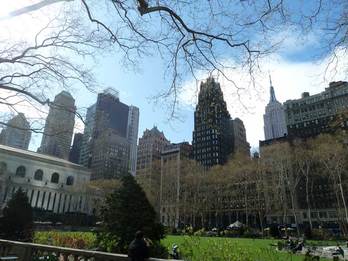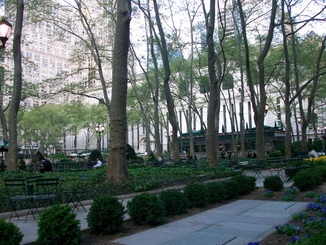Bryant Park - New York, NY
Bryant Park is an example of a park that, despite it's small size, plays an incredibly key role in the area in which it is located. It happens to be located in perhaps the busiest neighborhood in America, and therefore is a very natural attraction within it. Bryant Park is located just to the east of Times Square, the tourist epicenter of Midtown Manhattan in New York. Although it is only 9.6 acres in size, it provides an essential component of life in one of the most densely developed areas in the world. However, it's pristine present-day condition is not coincidental, and has taken plenty of effort.
The fortunes of Bryant Park have coincided with the trajectory of not only the Times Square area but also New York City as a whole. Although the park site has been designated as public land since 1686, it was not until 1847 that the first official park opened, then known as Reservoir Square. It was used for military drills during the Civil War, and it was finally named Bryant Park in 1884 after William Cullen Bryant, a notable New York Evening Post editor and abolitionist. By 1899, the reservoir on the site had been removed and construction began on the famous New York Public Library, which overlooks the park to this day. It was in this era of development at the turn of the century that much was invested in the park, including landscaping, terraces, and public facilities. However, the park quickly fell into neglect during much of the twentieth century.
The fortunes of Bryant Park have coincided with the trajectory of not only the Times Square area but also New York City as a whole. Although the park site has been designated as public land since 1686, it was not until 1847 that the first official park opened, then known as Reservoir Square. It was used for military drills during the Civil War, and it was finally named Bryant Park in 1884 after William Cullen Bryant, a notable New York Evening Post editor and abolitionist. By 1899, the reservoir on the site had been removed and construction began on the famous New York Public Library, which overlooks the park to this day. It was in this era of development at the turn of the century that much was invested in the park, including landscaping, terraces, and public facilities. However, the park quickly fell into neglect during much of the twentieth century.
|
The park, which featured all the potential of being a grand public centerpiece in the neighborhood, deteriorated during the city's economic and social struggles that reached a boiling point in the 1970s. The neglect really began in the 1920s, when the northern half of the park was closed due to the construction of Interborough Rapid Transit (IRT) subway tunnel that was being constructed along 42nd Street, as the city used the valuable space to store equipment. Over time, the park lost favor with much of the community, and a seedy element began to move in, much like nearby Times Square. In the 1970s, the park became a notorious spot for all sorts of unsavory activity. Drug dealers, prostitutes, and homeless people dominated the park, and it was considered by the larger public to be unsafe and even dangerous. By the turn of the 1980s, several concerned citizens teamed up to address the future of the park.
|
It was in this spirit that the Bryant Park Corporation was born. A group of prominent citizens and nearby property owners had a vested interest in restoring the park to its original intended glory, while also revitalizing the surrounding neighborhood. It was initially supported by the Rockefeller Brothers Fund, but has since transitioned to a funding based on assessment from nearby businesses and property owners, who all enjoy the benefit of close access to the revitalized park. Between the 1980s and the 2000s, the park underwent a radical transformation as a result of this effort. Due to the Corporation's effort's, which controls the park's operations, the park has a dedicated maintenance staff, has improved street entrances, outstanding public facilities, and an extensive collection of public seating, which is a main attraction to the park in it's dense surroundings.
Currently, Bryant Park is one of the key examples of the revival of New York City at the turn of the twenty-first century. The park is an important functioning element of life in busy Midtown Manhattan. It is a place to gather and relax, rather than to avoid. Real estate values in the surrounding area have skyrocketed, and Bryant Park has definitely contributed to it. It is a prime example of a group of concerned citizens taking charge and redirecting a valuable public land for the beneficial use of the public. The result is one of the most popular public spaces in New York City.



